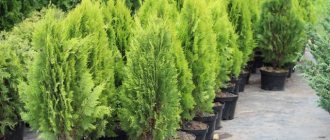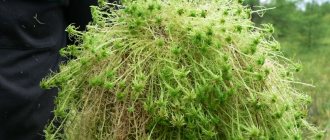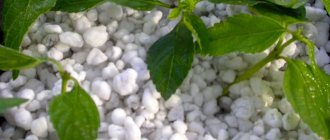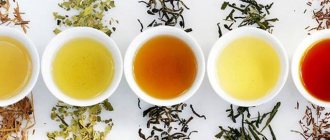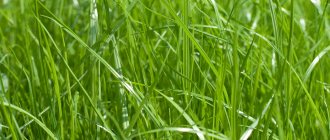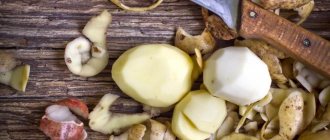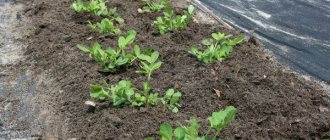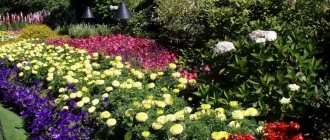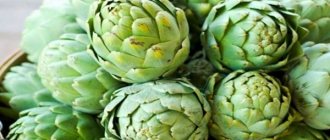What to consider when choosing plants
- How much area along the fence do you intend to plant?
- Is it the shady side or the sunny side.
- What exactly are plants needed here for - to protect the site or to decorate it.
- How tall would you like the trees and bushes to be here?
- Should they require special care or is it better to get by with plants “without whims”.
- You must know the characteristics of the soil into which you are going to move new residents and take into account the local climate.
- And be sure to keep in mind: a small garden plot should not be overloaded with massive plants.
Defining tasks and goals
When choosing green spaces, it is not enough to act on a whim; the organization of landscaping must be done thoughtfully. To begin, you need to answer the following questions:
An example of planting ferns along a fence
- the planted shrubs will have a protective or decorative function;
- what will grow from the bush in the future, its height and spreading nature;
- how much area can be allocated for plants;
- the sunny or shady side of the fence at the planting site;
- opportunities for caring for plantings (if the owner rarely appears at the dacha, perhaps a choice should be made in favor of the most unpretentious plants);
- climatic features of the region - not all plants you like are suitable for certain weather conditions;
- soil features on the site.
Return to contents
Fashionable mixborders
This is when flowers and shrubs are combined. In this case, you can plant thuja, juniper and other types of conifers. Dwarf varieties of trees and bushes would also be appropriate. And of course there is a riot of flowers, which are selected so that they bloom at different times. These will be wonderful bright spots that attract attention.
But with such landscaping, you need to take into account the condition of the fence, which also will not go unnoticed. So before you start planting, you should put the fence in order.
Flowers along the fence will be good both in the form of complex compositions and in the form of simple flower beds with simple plantings.
Or you can bet on tall flowers. For example, plant dahlias in front of the fence. These bright large flowers will always distract passers-by from wanting to look into the yard.
What to plant along the fence at your summer cottage: TOP plants
Landscape designers assure that not all plants are planted along the fence. First of all, it is determined which area will be landscaped. All plants along the perimeter of the site can perform only two functions: decorative or protective. The height of plants is very important, as it allows you to create shadows or, conversely, light space. Caring for plants along the fence is an important issue. Finally, it should be noted that you should not plant many plants in a small area.
Choosing plants to plant along the fence
The combination of bushes and flowers is called mixborders. So, dwarf coniferous trees such as thuja or juniper are planted. We select flowers so that they bloom at different times of the year. Before planting plants along the fence, you need to tidy up the fence itself.
Photo: Dahlia flowers along the fence
Both separately growing flowers and small flower beds are planted near the fence. You can always plant dahlias , for example. More and more often you can see people planting large plants along the fence. They will not only protect the imperfections of the fence, but will also protect you from the views of neighbors while you are relaxing on the site.
Caring for plants along fences is not difficult. Dogwood is the most popular shrub that is planted along fences. The plant develops quickly and caring for it is not very difficult. With the help of its cutting, you can form any shape of the bush. Turf seedlings planted in the spring grow a meter in height by autumn. However, remember that derain needs a lot of space. If you are ready to sacrifice it, then feel free to buy this plant.
Shrubs
And yet, most gardeners strive to decorate fences with more “solid” plants. For example, bushes can be used to camouflage an inconspicuous fence and reliably isolate oneself from neighbors. They are easy to care for. As a rule, they do not entwine the fence and do not spontaneously grow throughout the area.
What bushes are best to plant along the fence? Among the most popular is derain. It has an unusually interesting color with a silvery touch. And if you place low conifers nearby, the composition will turn out to be very interesting.
Derain is easy to cut and shape. It forms perfectly and quickly forms reliable protection against dust.
If you plant a seedling in the spring, then by the beginning of autumn it will be a meter tall. Many are attracted by such a new settler, but we must keep in mind that the derain needs a decent living space. Therefore, if you want to see more different bushes along the fence, you need to take a closer look at other species.
A good idea is to plant Thunberg barberry along the fence. These bushes have a beautiful spherical shape and reach a height of 90 cm. The matte leaves acquire a red-yellow hue with the onset of autumn. The fence looks very impressive at this time.
When planting, you should take into account that barberry does not like shaded places and does not react well to cold northern winds, so it is better to place it on the western or southern side of the fence. But gardeners will have no problems with watering: rainwater is enough for barberry.
Derain and barberry do not tolerate proximity to each other, since they have different requirements for the composition of the soil and the amount of moisture. Some of these bushes will not demonstrate their best decorative qualities.
What’s wrong with spirea, which is also called viburnum-leaved vesicle? It also grows quickly; literally a few months after planting, the bushes, strewn with luscious foliage, form a full-fledged hedge.
But to complete the picture, the spirea definitely needs to be cut so that it is not shapeless.
Take a closer look at such famous shrubs as lilac, hawthorn, elderberry, and chokeberry. All of these plants are fast-growing and can hide a fence in a short time. You can plant them in groups, with lower, trimmed bushes in front of them. Very original options can come out.
Well, if the owners want to combine business with pleasure, then they can plant berry bushes along the fence. Here you have a fence and an annual harvest of raspberries, currants, gooseberries, and rose hips.
Very important! Shrubs should not be placed close to the fence. When planting, dig holes at a distance of 1-2 meters.
Flowers
If you have a beautiful stone, wooden or wrought iron fence, you can highlight it with a lush and colorful flower bed. Plant flowers in one or several rows, in a ladder, as well as in complex decorative compositions.
Roses
Roses are very capricious and require fertile soil, regular watering and fertilizing. They are sensitive to drafts, lack of light and any other external irritants. But if you manage to grow a hedge of roses, your garden will become truly royal.
Rudbeckia
Rudbeckia is often found in areas in our latitudes, but not everyone knows its name. The flower with large yellow inflorescences is popularly called the “golden ball”. Rudbeckias are propagated by regular sowing and look very good in large groups along the fence.
Mallow
Mallow is an unpretentious perennial that pleases with its flowering until mid-autumn. It reproduces easily and does not require complex care throughout the season. Mallow grows very tall, so it is suitable for camouflaging a not very beautiful and neat fence.
Sunflower
Tall and bright sunflowers are not the most obvious choice for decorating an area. But think: they are large, beautiful, unpretentious and stretch 1-1.5 meters towards the sun! Behind such flowers you can easily hide even the most inconspicuous fence in your country house.
Primrose
Primrose is ideal for small decorative flower beds. It amazes with a riot of colors and quickly blooms with the onset of warm weather. While other plants are just waking up after winter, primrose is already pleasing with its delicate beauty. It's also grown as a perennial, so you don't have to re-sow the seeds every spring.
Lavender
Lavender grows in delicate, fragrant clumps and looks great along fences and garden paths. It will immediately fill your plot with the spirit of the French province, but in return it will require a lot of light and abundant watering. Contrary to stereotypes, lavender is not only purple, but also white, pink or blue.
Violets
Violet is wonderful for creating the last layer of multi-layered compositions or for mixed mixboards. Its flowers can be purple, lilac, soft blue or deep burgundy, almost black. Violet loves shaded places, and this will be provided by plants higher along the fence.
Peonies
Peony is another luxurious perennial that you only need to plant once and enjoy its beauty every season. It grows in tall, spreading bushes with large flowers, making it great for planting along a fence. Peonies do not require constant feeding and complex care, despite their amazing decorative properties.
Lily
It is impossible to remain indifferent to the exotic beauty of lilies. A huge variety of varieties are distinguished by the most bizarre colors. But keep in mind that lilies require free space and do not tolerate shading by tall trees. Therefore, it is better to plant them solo along the fence or combine them with low-growing flowers.
Tulips
Bright multi-colored tulips are planted independently only along low borders when creating garden paths and landscape compositions. But they perfectly complement the flowering mixboards along the fence around the site. Choose varieties with different flowering periods - and they will delight you from the first days of spring until summer.
Trees
The usual picture: in most summer cottages, fruit trees grow along the fences, performing a double function: they serve as a fence and regularly bear fruit. However, recently, summer residents have been thinking not only about benefits, but also about beauty, and are striving to surround their properties with ornamental trees. Luxurious maples, chestnuts, modest willows, birches, and lindens are planted.
But coniferous trees, especially spruce, can probably be called gardeners’ favorites. However, by doing so, summer residents are restoring the old tradition of decorating their farmsteads with conifers.
This should not be done spontaneously. In order for a composition of young Christmas trees to be truly beautiful, you need to plant them at a distance of about 30 cm and monitor their development, constantly cutting them in width and height.
Wondering what plants to choose for a hedge?
What types of decorative fences there are - original and different - can be found in our article.
Complex landscape architecture
It is not necessary to arrange continuous plantings along the fence; in landscape architecture, a solitary or single arrangement of shrubs, which can be tied to a nearby flower bed, for example, looks interesting. For single plantings, you should choose decorative deciduous or beautifully flowering shrubs. Viburnum buldenezh, spirea, lilac, and scumpia are suitable.
When planting along a fence, shrubs are placed at a distance of at least a meter from its plane, even if it is a mesh. With this arrangement, standards will be met and the possibility of fully organizing garden care will be ensured.
To save space along the fence, you can plant climbing plants. If the fence is solid, then to be able to braid it, you need to install an additional mesh or stretch vertical threads.
Planting perennial climbing plants supported by a fence must be done with caution. The green mass can gain too much weight and knock down the fence. In addition, shoots “creeping” to the neighbors’ side are unlikely to turn out to be a pleasant surprise. Another nuance is that increased dampness constantly remains inside the green mass of perennial plants.
Popular climbing plants that are undemanding to soil and conditions include ivy and virgin grapes.
You can take up space along the fence with maximum benefit by planting rows of raspberries, for example, in a sufficiently illuminated place. In any case, when solving the problem of what to plant along the fence , you need to go through all the options and settle on the most interesting one, which may involve combining plantings of different plants.
You can read an article about how to sow a lawn here.
If you find an error, please select a piece of text and press Ctrl+Enter.
0
Back
How to plant a lawn: instructions for a beginner
MORE
How to plant trees
The first line you need to plant is low conifers. This could be, for example, blue spruce. And tall trees will remain in the background.
Deciduous trees with a creeping crown (birch, willow) should be planted in the background, and in spots.
Trees and many shrubs, as a rule, have a developed root system, so there must be a distance of at least 3-5 meters between the seedlings and the fence, otherwise over time the roots will destroy the main fence.
This is also important because the fence will shade young plants, which will affect their growth.
We must also remember that during development, tree roots grow and cling to each other. That is why it is best to plant trees in a pre-dug trench in one row. This method will give a good result: the trees along the fence will form an even thick line.
What to plant along the fence at the dacha: trees, bushes, plants, options in the photo
In order to beautifully decorate places near the fence with flowers and trees, you should know some important subtleties about the placement of different types. Let's start with the trees.
Before selecting trees for landscaping the space near the fence, you must first learn some of the subtleties of planting:
- To prevent the fence from being damaged by roots, it is important to consider the distance between it and the tree . The optimal distance is about 3 or 5 meters . Consider not only the tree's current size, but also its expected future size of the crown and root system.
- Calculate in advance the area of the shaded area near the fence and trees . Consider what plants can be planted nearby.
As a rule, our compatriots traditionally plant fruit trees, such as apple trees, near fences. But special varieties of trees have long existed to decorate this area. Here they are:
- Maples with various shades of foliage, for example, Tatarian.
- Willow.
- Linden.
- Buckthorn
- Dwarf birch trees.
- Chestnut.
- Coniferous species, for example, thuja.
Due to trees, it is quite possible to increase the height of the fence. This is easy to do - plant trees in a row. As soon as the crowns touch, they begin to be cut regularly. Linden and elm lend themselves best to the procedure . The first one will also delight you with an unforgettable aroma during the flowering period.
It is important to consider the purpose of the tree near the fence. For example, you can completely close your area from prying eyes. Or you might just want to give the fence a more decorative look. We will talk about which trees can be planted for different purposes a little later. What shrubs are suitable for planting?
Shrubs for places near the fence
Shrubs planted here have many advantages:
- Transformation of a not very aesthetic fence.
- Enrichment of air with oxygen.
- Purifying the air from dirt and dust if the site is located along roads.
- Easy to care for.
Deren . The shrub is absolutely unpretentious and is a favorite of many gardeners. Its variegated leaves transform any area and fence. Derain grows well in any territory, including Siberia. In summer it is decorated with flowers, and in autumn - white fruits. Perfectly amenable to shaping by cutting.
Spirea. If you combine several varieties of plants, you can get a flowering “wall” for the whole summer and early autumn. The bush is very easy to care for and does not require frequent watering or fertilization. Excellent moldability. It also grows well without pruning.
Lilac. Of course, she takes pride of place in the polling stations. However, it is difficult to call lilac unpretentious - it needs good lighting and a low groundwater level . The most frost-resistant variety is Amur lilac . Without proper care, the bush will not look very presentable. So lilacs should be planted only if there is time for care.
How to choose plants for the fence
The main fences near which plants are to be planted come in different types. And for each one you need to choose the right trees, shrubs or other plantings.
Rabitz
One of the most popular types of country fence. Not the worst option, but its transparency sometimes does not suit land owners. For example, they want to isolate themselves from nosy neighbors.
The chain-link has a design that is convenient for climbing plants. There is, however, a drawback: you will have to be especially careful to ensure that the mesh does not deform under the heavy weight of the vines or rust.
Hops form a green barrier very quickly. But it is painfully tenacious: very soon it will fill both the owner’s plot and the neighboring one. Fighting escapes is quite difficult.
It is more practical to plant virgin grapes or echinocystis along the fence. They also grow quickly, but they are easy to remove.
A good option to securely close the net is to sow the beans as densely as possible. Or, for example, plant Jerusalem artichokes right under the fence - not only will the fence grow tall, but it will also bring a harvest of useful root crops.
Wooden fence
Any shrubs will do well near a wooden fence. This could be, for example, hawthorn or elderberry. Any vine (grapes, hops) will grow.
Fruit trees (cherry, plum) are also appropriate. You can plant hydrangea, barberry, lilac, thuja. All of them are unpretentious and attractive.
Fence made of steel corrugated sheets or corrugated sheets
Strong plants should be planted along such a fence, since the fence material will heat up from the sun's rays, and the plants may not withstand such a heat attack. It is best to paint such a fence before planting.
By the way, many gardeners dispute this opinion and believe that jasmine, lilacs, raspberries, and many vines thrive along such a fence.
Fence decor made from various materials
Depending on the material from which the fence is made, you need to select appropriate plants for landscaping. It is recommended to give preference to unpretentious varieties, since their care is minimal.
Rabitz
If the fence is made of chain-link, then the territory of the dacha remains open to the eyes of strangers. To prevent this, it is recommended to plant climbing species near the fence, which will entwine the mesh and subsequently become a kind of green “wall”.
- Wild grapes. Fast growing culture. It does not need either strict feeding or abundant watering. Grows on any soil and is resistant to drought. But the downside of grapes is that their branches grow actively; if they are not trimmed in a timely manner, they can “spread” onto the roof, windows, and walls of the house. The situation can be corrected if you trim off the “extra” lashes in a timely manner.
- Hop. The plant is unpretentious and actively growing. Hops grow quickly and quickly cover the chain-link mesh with their succulent foliage. In addition to basic care (watering, loosening the soil, weeding), hop branches must be trimmed regularly.
- Ivy. The active growth of ivy is not its main advantage. It has bright, juicy greenery that retains its original appearance even in winter. Ivy requires certain care: regular watering, a sufficient amount of incoming sunlight, treatment against diseases and various pests.
- Climbing roses. Climbing roses will create a gorgeous look at your summer cottage. The flower has a lot of advantages: gorgeous juicy greens, bright fragrant flowers, active growth, unpretentiousness. But in order for the rose to be strong, it must be periodically fed with mineral and organic compounds.
- Beans. It grows instantly and soon covers the mesh cells with bright greenery. Another advantage of beans is that, in addition to decoration, they produce a useful harvest.
Corrugated sheet
Various plants can be planted along a fence made of corrugated sheets. But when planting, it is important to follow one rule: you cannot plant close to corrugated sheets. This is necessary so as not to destroy the bushes, since the corrugated sheet quickly heats up under the influence of the sun.
Shrubs and actively blooming tall flowers, herbs, and any types of cereal grasses will look good along the corrugated board fence.
To decorate the site, it is better to choose unpretentious frost-resistant types of crops. It is not recommended to decorate the fence with plants that require certain conditions for active growth.
When to plant trees and shrubs
It doesn’t matter whether you plant or replant plants - it’s better to do this in the fall. Experts also practice winter planting, but this is a task beyond the capabilities of summer residents.
There is such a rule: plant ornamental bushes that bloom in spring in autumn; if they bloom at the end of summer, you can plant them in the spring. As you can see, for most shrubs the planting time is still autumn.
This season is also good because there is no need to rush, fearing that the buds are about to open. The main thing in autumn planting is that the seedlings can take root before severe frosts. Well, in the middle zone it is difficult to predict the cold season, so it is better to complete all planting work by mid-October.
If for some reason it was not possible to plant trees or shrubs by this time, you can take a chance and do it a little later. But at the same time, the roots need to be protected from the cold. They do it this way: generously mulch the tree trunk circle with peat, sawdust, leaves, etc.
If it’s frosty outside, planting trees and shrubs is impossible. They need to be given an inclined position, buried with earth and sprinkled with mulch. And plant in a permanent place with the onset of spring.
The situation is simpler with plants grown in containers. They can practically be planted at any time. The exception is evergreen bushes and trees or plants blooming at this moment.
Where to begin?
Experts advise planning and placing trees and shrubs along the fence and paths immediately, simultaneously with planning a suburban building. An integrated approach to organizing and filling space will allow the summer cottage site to acquire a lived-in appearance by the end of construction work, be filled with greenery and look like a real kingdom of nature.
Site plan with location of shrubs
Before starting landscaping work, inspect the area, familiarize yourself with its advantages and pay attention to its disadvantages, evaluate the possibilities and conditions for planting. This is very important for choosing varieties and varieties of trees and shrubs.
When arranging a suburban area, in order to maintain the harmony of all components and get a complete space, it is better to pay attention and be guided by the recommendations developed by specialists. Before deciding which plantings will grow near the fence, which bushes inside the territory, you need to pay attention to the suburban space and get answers to the following questions:
1. Decide on the purpose of the bushes and trees used for landscaping the site. Figure out what your goal is when planting: to close an ugly fence or to decorate a lovely structure. Choose what main function the plants will serve: to camouflage the fence or to harmoniously coexist with it.
Masking a fence with bushes
2. Determine for yourself what part of the space falls under the control of trees and shrubs, and how much free space it costs to leave. Do not overload the area. Excessive loading of trees and shrubs along the fence, especially tall plants, will visually reduce the area and make it oversaturated.
Shrubs along the paths should not overload the space
3. Determine which side of the fence is available for planting: brightly lit by the sun or constantly in the shade. When planting trees, focus on the shade cast by the fence and plant plants that grow well in those shady conditions.
Barberry bushes tolerate shade well
4. What is the soil like in the area of future planting? In order for a plant to truly reveal its decorative properties, it must grow in comfortable conditions.
5. How much subsequent care is expected for the plant. Is it possible to provide constant attention to the capricious flora, to provide pruning and shaping of trees and shrubs that need it?
Hedges need regular maintenance
There are two options for the formation of vegetation on a personal plot:
1. Landscape planning does not require special human participation. This method of forming a territory is especially suitable for areas located on uneven terrain. In this case, due to the natural difference in levels, the plants look beautiful and together form interesting compositions.
Free landscape planning of the site
2. Geometric layout involves maintaining certain distances between bushes and trees and maintaining strict geometric shapes. Most often, in this case, rows of densely planted trees are created. There is empty space between the rows and lonely vertical plants in the middle of the plot.
Strict geometric layout of the site
